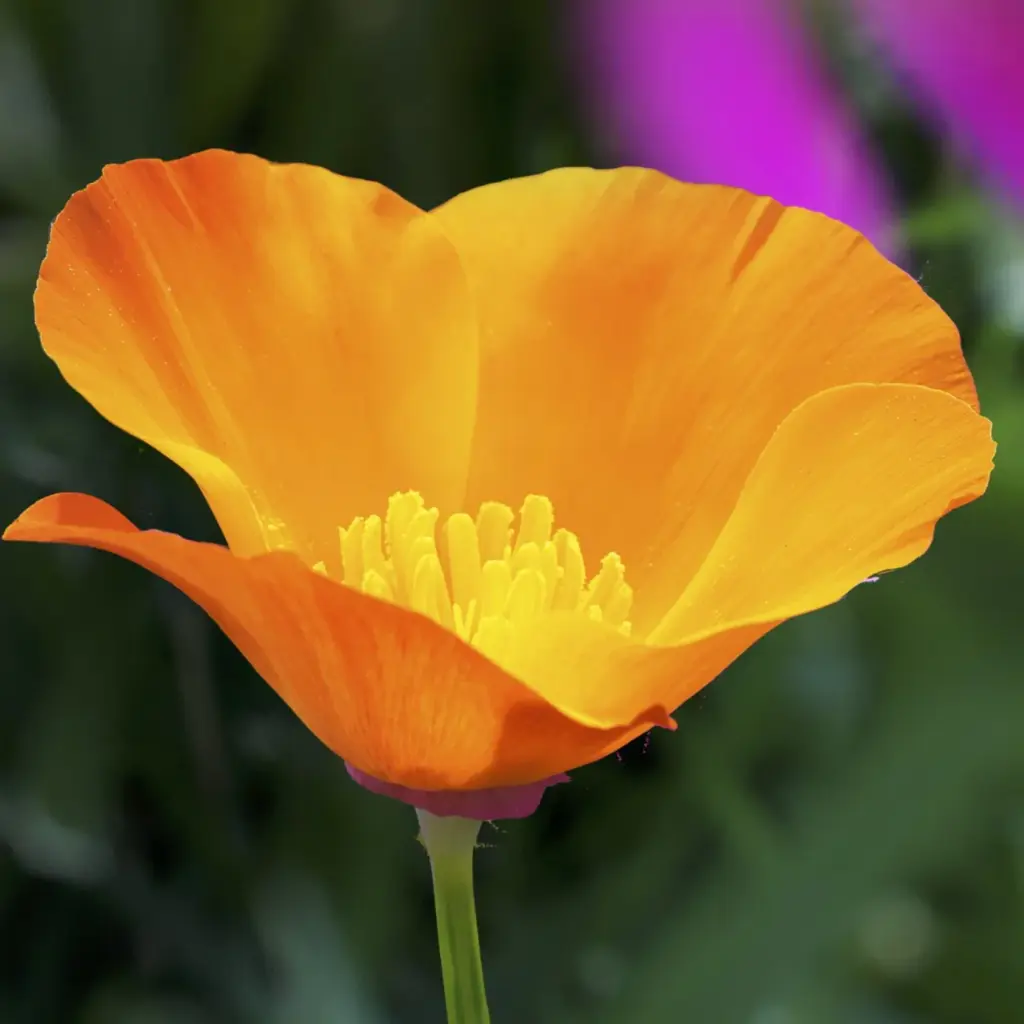California poppy, scientifically known as Eschscholzia californica, is a vibrant and resilient flowering plant that adds a splash of color to gardens and landscapes. Native to the western United States, this hardy annual is beloved for its brilliant orange, yellow, and red flowers that bloom from spring to fall. In this comprehensive guide, we will explore everything you need to know about growing California poppies, from planting to caring for these beautiful flowers. We’ll also provide a seasonal guide to ensure your poppies thrive.
Introduction to California Poppy

Overview
California poppy (Eschscholzia californica) is a member of the Papaveraceae family. This drought-tolerant plant is known for its bright, cup-shaped flowers and finely divided, blue-green foliage. It is the state flower of California and thrives in a variety of soil conditions.
History and Symbolism
California poppy has been used by Native American tribes for centuries for its medicinal properties. It symbolizes beauty, success, and resilience and is often associated with the state’s rich natural heritage.
Why Grow California Poppy?
California poppies are easy to grow, low-maintenance, and excellent for pollinator gardens. They attract bees, butterflies, and other beneficial insects, making them a valuable addition to any garden. Their vibrant colors and long blooming period add visual interest and beauty to landscapes.
Selecting the Right Location
Climate and Hardiness
California poppies are hardy in USDA zones 8-10. They thrive in regions with mild, wet winters and hot, dry summers. However, they can be grown as annuals in cooler climates.
Sunlight Requirements
These flowers prefer full sun and need at least 6 hours of direct sunlight each day. They can tolerate partial shade but may produce fewer flowers.
Soil Conditions
California poppies thrive in well-draining soil and can tolerate poor, sandy, or rocky soils. They do not do well in heavy, clay soils that retain moisture. The ideal pH range is slightly acidic to neutral (6.0-7.0).
Preparing the Soil
Soil Preparation
To prepare the soil for planting California poppies:
- Test Soil Drainage: Ensure the soil drains well by checking for water retention.
- Amend Soil: If necessary, amend the soil with sand or gravel to improve drainage.
- Remove Weeds: Clear the planting area of weeds and debris to reduce competition for nutrients and water.
- Till Soil: Loosen the top 6-12 inches of soil to create a favorable growing environment.
Planting California Poppy Seeds
When to Plant
California poppy seeds can be sown directly in the garden in the fall or early spring. Fall planting is preferred in mild winter climates, allowing the seeds to establish before blooming in spring.
How to Plant
Follow these steps to plant California poppy seeds successfully:
- Scatter Seeds: Scatter the seeds evenly over the prepared soil surface. These seeds need light to germinate, so do not cover them with soil.
- Press Seeds: Lightly press the seeds into the soil using your hand or a flat board to ensure good seed-to-soil contact.
- Water: Water the area gently to moisten the soil without washing away the seeds.
- Thin Seedlings: Once seedlings have developed a few leaves, thin them to about 6-8 inches apart to prevent overcrowding.
Seasonal Care Guide
Here’s a handy seasonal guide to help you manage your California poppy care throughout the year:
| Jan | Feb | Mar | Apr | May | Jun | Jul | Aug | Sep | Oct | Nov | Dec | |
|---|---|---|---|---|---|---|---|---|---|---|---|---|
| Planting | yes | yes | yes | yes | ||||||||
| Flowers | yes | yes | yes | yes | yes | |||||||
| Pruning | yes | yes |
Seasonal Care and Maintenance
Spring
In spring, focus on ensuring your California poppies receive adequate water, especially if there are dry spells. Apply a balanced fertilizer to support vigorous growth and abundant flowering. Keep the area weed-free to reduce competition.
Summer
During the summer, California poppies will be in full bloom. Water them moderately, allowing the soil to dry out between waterings to prevent root rot. Deadhead spent flowers to encourage continuous blooming.
Fall
In the fall, after the flowering period has ended, you can collect seeds from the seed pods for future planting. Cut back any dead or dying foliage to tidy up the garden. This is also a good time to plant new seeds for the next season.
Winter
In mild winter climates, California poppies can remain evergreen. In colder regions, the plants may die back, but seeds sown in the fall will lie dormant until spring. Minimal care is needed during this period.
Common Problems and Solutions
Pests
California poppies are generally pest-resistant, but they can occasionally be affected by:
- Aphids: Small, sap-sucking insects that can cause distorted growth. Control with insecticidal soap or neem oil.
- Slugs and Snails: These pests can damage young seedlings. Use barriers or natural predators to control them.
Diseases
Common diseases include:
- Powdery Mildew: A fungal disease that appears as white, powdery spots on leaves. Improve air circulation and apply fungicides if necessary.
- Root Rot: Caused by waterlogged soil. Ensure proper drainage and avoid overwatering.
Environmental Stress
- Heat Stress: In extremely hot climates, provide some afternoon shade and ensure adequate watering.
- Frost Damage: Protect young seedlings from late frosts by covering them with a frost cloth.
Propagating California Poppy
From Seeds
California poppies are best propagated from seeds. Collect seeds from mature seed pods after flowering. Store seeds in a cool, dry place until ready to plant.
From Cuttings
While less common, California poppies can also be propagated from cuttings. Take softwood cuttings in spring or early summer and root them in a well-draining mix.
Uses and Benefits
Ornamental Uses
California poppies are primarily grown for their ornamental value. They can be used to:
- Create Mass Plantings: Ideal for meadows, wildflower gardens, and borders.
- Add Color to Containers: Grow them in pots for vibrant patio displays.
- Enhance Pollinator Gardens: Attract bees, butterflies, and other beneficial insects.
Medicinal Uses
California poppy has been used in traditional medicine for its sedative and pain-relieving properties. Always consult with a healthcare provider before using any plant for medicinal purposes.
Edible Uses
While not commonly consumed, the petals of California poppies can be used as a colorful garnish in salads.
Conclusion
Growing California poppies is a rewarding experience that brings a burst of color and joy to your garden. By selecting the right location, preparing the soil, and following proper planting and care practices, you can enjoy a stunning display of these vibrant flowers year after year. Whether you’re planting in a garden bed or container, California poppies are sure to enhance your outdoor space with their beauty and resilience. Happy gardening!
Additional Tips for Success
- Companion Planting: Plant California poppies with other drought-tolerant plants such as lavender, sage, and yarrow to create a cohesive and low-maintenance garden.
- Watering: Be mindful of your watering schedule. Overwatering can lead to root rot, while underwatering can stress the plants. Allow the soil to dry out between waterings.
- Mulching: Apply a layer of mulch around the base of the plants to help retain moisture and suppress weeds.
- Fertilizing: California poppies do not require heavy fertilization. A light application of a balanced fertilizer in spring can support healthy growth.
By following these guidelines, you can ensure that your California poppies thrive and provide a stunning display throughout the growing season. Whether you’re a seasoned gardener or a novice, these vibrant flowers are a wonderful addition to any garden. Enjoy the beauty and simplicity of growing California poppies, and let their cheerful blooms brighten your outdoor space.



